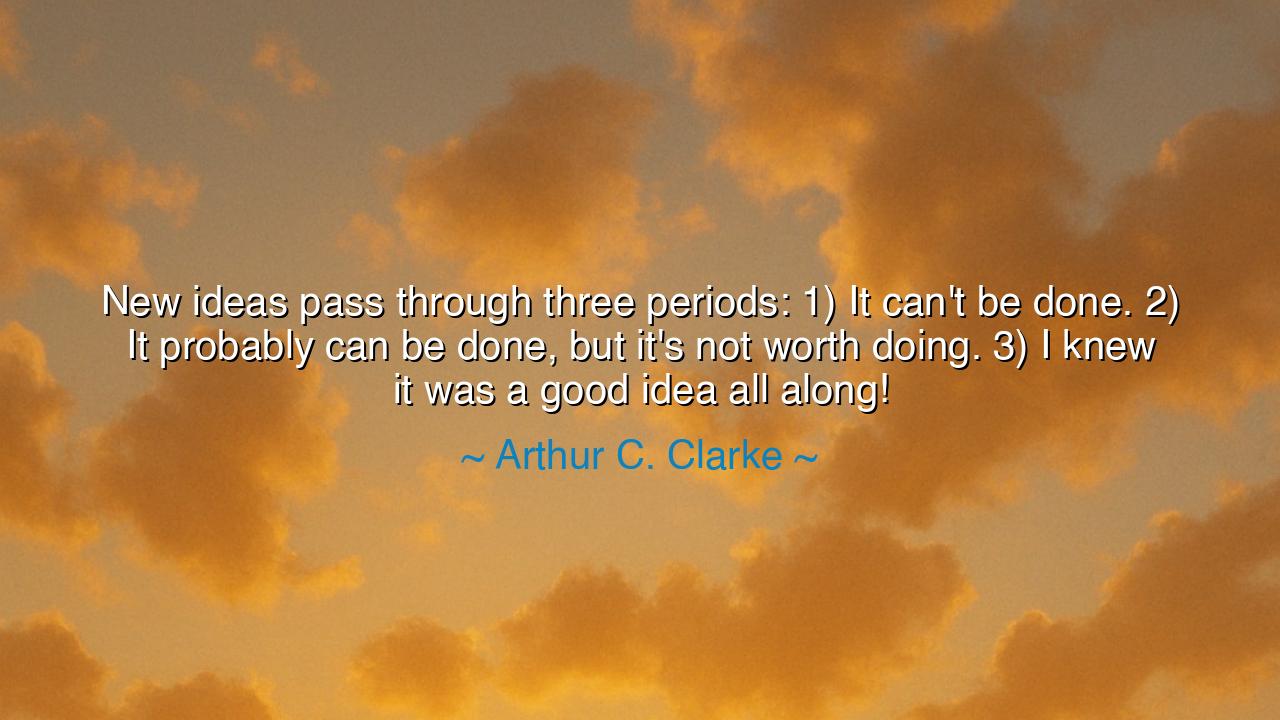
New ideas pass through three periods: 1) It can't be done. 2) It
New ideas pass through three periods: 1) It can't be done. 2) It probably can be done, but it's not worth doing. 3) I knew it was a good idea all along!






"New ideas pass through three periods: 1) It can't be done. 2) It probably can be done, but it's not worth doing. 3) I knew it was a good idea all along!" Thus spoke Arthur C. Clarke, the visionary of stars and mind, whose words echo through the corridors of progress like a timeless truth about the journey of all creation. In this saying, Clarke reveals the eternal rhythm of innovation—the threefold trial through which every new idea must pass before it is crowned with acceptance. He reminds us that mankind, though curious and clever, often greets the unfamiliar not with open arms, but with resistance, doubt, and pride. The path of discovery, therefore, is not smooth, but marked by disbelief, indifference, and eventual imitation.
The origin of this quote lies in Clarke’s lifelong meditation on the relationship between imagination and reality. As one of the great prophets of science fiction, he envisioned worlds beyond the reach of his time—satellites circling the Earth, voyages to distant planets, machines that could think. Many of his ideas, once dismissed as fantasy, later became fact. Clarke lived in an era where technology seemed to leap faster than belief, and he saw firsthand how the world responds to genius: first with laughter, then with hesitation, and finally with envy disguised as praise. His words, therefore, are both a lament and a celebration—a recognition that progress must always wrestle with human nature before it can take its place among the accepted truths.
The first stage—“It can’t be done”—is the cry of fear disguised as wisdom. Whenever something new appears before the eyes of man, his instinct is to defend the old, to protect what he knows. The walls of habit rise quickly against the winds of change. When Galileo pointed his telescope toward the heavens and declared that the Earth moved around the Sun, he was condemned as a heretic. The learned men of his day, chained to the safety of ancient dogma, could not bear to imagine that their universe might be wrong. Yet time, which tests all things, proved him right. Every new truth, like the dawn, must first be resisted by those who cannot yet bear its light.
The second stage—“It probably can be done, but it’s not worth doing”—is subtler, yet equally powerful. It is the voice of cynicism, of those who see possibility but lack vision. Here, fear turns into condescension; innovation is tolerated, but not embraced. When the Wright brothers first flew at Kitty Hawk, few believed that flight would ever have meaning beyond spectacle. Even great thinkers of the time called airplanes toys of no practical value. Yet within a single generation, the sky itself became man’s highway, and the dream that was once dismissed as folly became the foundation of a new world. Thus, in every age, mediocrity tries to diminish greatness—not because it cannot see what is possible, but because it cannot imagine what it will mean.
Then comes the third and final stage—“I knew it was a good idea all along!”—the moment when the once-despised idea becomes part of the accepted world. The critics vanish; the doubters rewrite their memories; those who once mocked now claim kinship with success. Such is the fate of every great thought: after it has changed the world, it becomes invisible, taken for granted, as if it had always been there. When electricity, the printing press, or the internet transformed civilization, each passed through this cycle of scorn, skepticism, and acceptance. The inventors suffered rejection; the world reaped the reward. Clarke’s wisdom reminds us that the glory of innovation is not in being believed, but in believing when no one else will.
But beneath Clarke’s humor lies a deeper truth: that progress depends not only on intelligence, but on courage—the courage to stand alone. Every thinker, artist, or dreamer must endure these three periods, for humanity advances not by consensus, but by conviction. The new idea is like a seed planted in hard ground; it must push through layers of doubt before it reaches the light. The one who dares to imagine the impossible must also endure misunderstanding, for he sees what others cannot yet perceive. Yet history honors only those who persist—who keep faith in their vision when all the world declares it impossible.
So, my children of thought and aspiration, take this teaching into your hearts: do not fear rejection; fear only the loss of imagination. When your ideas are scorned, remember Clarke’s words and smile—for you are walking the same road as the inventors, philosophers, and artists who shaped the world. When others say, “It can’t be done,” let that be your signal to begin. When they say, “It’s not worth doing,” let that be your fire to prove its worth. And when, at last, they say, “I knew it all along,” do not seek vengeance, but humility—for your victory will speak louder than your defense.
For this is the eternal cycle of creation: disbelief, resistance, and revelation. The world resists change because it fears its own transformation—but those who dare to dream pull humanity forward despite its fear. Arthur C. Clarke, who once imagined satellites and space travel, left us this truth as a lamp for all who dream: that every great idea begins as heresy, becomes struggle, and ends as self-evident truth. Therefore, hold fast to your vision, and do not bow before the doubt of others. The age that mocks you today will one day live in the world you imagined—and call it common sense.






AAdministratorAdministrator
Welcome, honored guests. Please leave a comment, we will respond soon